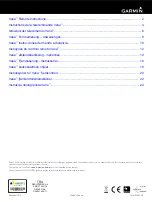
8
FAQ
FAQ
(2000
at
80%
DOD).
In
addition
there
are
safety
measures
built
into
the
pack
which
prevent
overcharging
and
rapid
discharging.
Finally
the
battery
case
is
made
of
high
grade
steel,
protecting
the
cells
from
damage,
and
containing
them
should
a
cell
breach
occur.
All
of
these
protections
mean
that
under
normal
usage
there
is
no
danger
of
a
fire.
The
dangers
of
spills
and
explosive
gas
buildup
from
lead
‐
acid
batteries
are
much
more
common
than
a
LiFT
Pack
catching
fire.
MISCELLANEOUS
What
happens
when
a
single
cell
fails
in
a
lead
‐
acid
battery
vs.
a
Flux
lithium
battery?
Lead
‐
acid:
When
a
single
cell
fails,
there
is
no
BMS
to
manage
the
charging.
Therefore
the
failing
cell
will
heat
up,
but
not
fully
charge.
The
failing
cell
will
accelerate
its
decline
as
it
is
used
improperly
and
cause
the
entire
pack
to
drain
rapidly
when
in
use.
As
an
example,
if
a
failing
lead
‐
acid
cell
is
at
50%
capacity,
the
charger
will
not
attempt
to
charge
it
to
its
full
(diminished)
capacity,
this
means
that
once
the
pack
is
used,
the
voltage
drop
will
be
significant
in
this
cell,
and
the
entire
pack
will
see
a
drastic
drop
in
run
‐
time
due
to
the
low
voltage
in
this
cell.
Flux
lithium
battery:
When
a
single
cell
beings
to
fail,
the
entire
pack
will
experience
a
reduction
of
run
‐
time
proportional
to
the
single
failing
cell’s
reduction
in
run
time.
The
BMS
will
still
charge
and
balance
the
cells,
but
the
pack
will
cut
off
when
the
failing
cell
voltage
drops
to
2.8
Volts.
As
an
example,
if
the
failing
cell
is
at
50%
capacity,
the
charger
will
still
charge
the
cell
to
full
(diminished)
capacity
and
the
cell
will
produce
the
expected
voltage,
just
for
50%
shorter
run
‐
time.
The
pack
will
then
run
as
if
it
has
50%
capacity.
The
BMS
will
protect
the
other
cells
from
harm
due
to
a
low
cell.
In
essence,
the
BMS
avoids
the
low
voltage
scenario
which
is
problematic
in
lead
‐
acid.
How
does
a
dealer
diagnose
a
battery
should
an
issue
arise?
The
State
of
Charge
indicator
lights
also
display
Diagnostic
Trouble
Codes
(DTCs)
which
are
detailed
in
the
Quick
Start
Guide
and
this
FAQ.
If
for
some
reason
the
problem
cannot
be
determined
using
the
DTCs,
Flux
will
provide
communication
cables
and
software
to
connect
to
the
pack
for
a
more
detailed
inspection
of
the
issue.
The
onboard
firmware
provides
detailed
reports
of
all
cell
and
pack
behavior,
making
diagnosis
of
a
problem
quick
and
easy.
Why
does
the
Flux
product
specification
sheet
show
a
voltage
higher
than
24V?
Lithium
cells
have
a
higher
nominal
voltage
than
lead
‐
acid.
The
Flux
LiFT
pack
is
comprised
of
8
Lithium
cells
connected
in
series,
each
with
a
nominal
voltage
of
3.2V.
The
pack
nominal
voltage
is
therefore
25.6V.
There
is
minimal
voltage
drop
as
the
pack
discharges,
and
under
normal
use,
the
pack
will
indicate
it
needs
to
be
charged
when
it
drops
to
~23
‐
24V.
Do
LiFT
Packs
require
periodic
maintenance?
No,
but
an
annual
inspection
is
recommended
by
an
authorized
dealer
to
ensure
maximum
battery
life.
How
can
we
offer
a
5
‐
year
warranty?
Based
on
average
usage
profiles
and
Flux
lithium
battery
packs
lasting
2000
cycles,
Flux
expects
the
LiFT
Packs
to
last
7
years
before
they
are
at
80%
of
their
original
capacity.
If
an
end
user
is
running
the
pack
24/7
and
cycling
the
pack
3
times
in
a
24
hour
period,
there
may
be
additional
decreased
capacity
after
the
5
year
mark,
but
the
pack
will
still
function
as
intended.
FLUX
Power
Inc.
985
Poinsettia
Ave.
www.FLUXpwr.com
Vista
CA,
92081
877
‐
505
‐
3589
Flux
Power
is
a
registered
trademark
of
Flux
Power
Inc.
990821v1.1


























